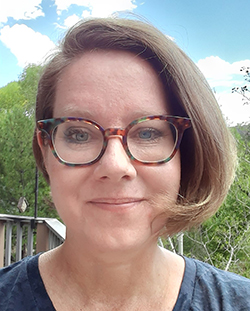 2021 National Board of Directors Election Candidate for Vice President
2021 National Board of Directors Election Candidate for Vice President
Kelli Warble
Teacher in Residence, Department of Physics, Arizona State University, Tempe, AZ 85281
kelliw@asu.edu
Education
- Master of Science and Technology Policy, Arizona State University, 2019
- Applied Project: Save Arizona Physics: How a small group of educators convinced state legislators to fund scholarships for teachers and influenced a national fellowship
- Post-Baccalaureate Certification in Secondary Education, mathematics and physics, Arizona State University, 1994
- Bachelor of Science, major: mathematics, minor: physics and electrical engineering, University of Arizona, 1990
Professional Experience
- Arizona State University, Physics Teacher in Residence, Learning Assistant Program Coordinator, instructor for Fundamentals of Physical Science and Methods of Teaching Physics, 2012-present
- Arizona State University Modeling Instruction Program and American Modeling Teachers Association, physics Modeling Workshop leader, co-developer and workshop leader for Middle School Modeling Workshops, 1998-present
- Knowles Teacher Initiative, United States, professional development leader and teacher advisor, 2007-2012, 2018-2021
- Arizona School for the Arts, Phoenix, AZ, 9th grade mathematics and science teacher, 2010-2012
- Dysart Unified School District, Surprise, AZ, high school mathematics and physics teacher, 2006-2010
- Buckeye Union High School, Buckeye, AZ, mathematics and physics teacher, 1994-2006
- Friendly House, Phoenix, AZ, head instructor for math and science enrichment programs at central-city Hispanic community center, 1990-1993
Honors
- Featured Speaker, “Physics for All: Teachers as advocates for policies that support students (and one another)” Harvard Physics of Living Systems Teacher (PoLS-T) network, March 2021
- MSTP Charter Award, Arizona State University School for the Future of Innovation in Society, for exemplifying the ASU Charter core values of access, excellence, and impact, Spring 2019
- Presidential Succession (currently Past President), American Modeling Teachers Association, 2017-2021
- Outstanding Teacher Award, Arizona State University of Department of Physics, 2016-2017
- Solicited Editorial: “Stories from the field: It seems as if no one is asking classroom teachers what will be most helpful,” created for 100kin10 Grand Challenges in STEM Education interactive site, September 2017
- Westside Impact Teacher of the Year, Buckeye Union High School, 2005-2006
Memberships
- American Association of Physics Teachers
- Arizona Section of the AAPT
- American Modeling Teachers Association
- STEMteachersPHX
- Physics Teacher Education Coalition (PhysTEC)
- Learning Assistant Alliance
AAPT Activities
- Arizona Section of AAPT, currently section representative, 2012-present
- AAPT Committee on Professional Concerns, 2017-2021
- Advisor to initial STEP UP propagation team working to inspire young women to pursue physics in college, 2018-2019
- Co-creator and emcee of AAPT/AIP Master Teacher Policy Fellowship empowering teacher-driven efforts to improve physical science education policies starting at the state level, Summer 2018-2019
- Invited Article: “Should We Prepare Future Teachers to Advocate for Effective School Policies?,” American Physical Society Forum on Education Newsletter, Spring 2019
- AAPT Lotze Scholarship Committee, 2017-2018
- Member of AAPT Physics Master Teacher Leader Task Force, 2016-2017
- Contributing Author: Aspiring to Lead: Engaging K-12 teachers as agents of national change in physics education, a report from the AAPT Physics Master Teacher Leader Task Force, May 2017
- Invited Article: “PER-based Teacher Preparation at Arizona State,” American Physical Society Forum on Education Newsletter, Summer 2016
Commentary
In the fall of 2016, I was privileged to work with a task force convened by the AAPT to craft an ambitious vision for how to ensure access to a high-quality physics education for all students in the United States. Our ideas were subsequently captured in the Aspiring to Lead report published in May of 2017. The report’s subtitle seemed targeted directly at inspiring me: “Engaging K-12 teachers as agents of national change in physics education,” it exclaimed. Finally! The importance and potential of elementary and secondary school teachers had been acknowledged! I felt empowered; I was connected to a formidable community of like-minded educators with a purpose that reached beyond the individual student or teacher.
But grand visions are complicated to implement. As a candidate interested in working on the board, I find myself wondering how the AAPT can ensure it is continuously striving to meet the vision of “physics for all” as set out in Aspiring to Lead.
My work as an educator has been greatly enhanced by AAPT-supported initiatives, each of which is a small step on the path to physics accessibility for all students. I rely on resources from the PhysPort website on a weekly basis. The shortage of physics teachers in my home state of Arizona is being addressed by a group of educators (the “Cactus Caucus”) supported by the AAPT/AIP Master Teacher Policy Fellowship—the Aspiring to Lead report put into action. I have shared STEP UP physics lessons with fellow educators of students from middle school to university. I leave every AAPT meeting with new ideas for my classes, and AAPT virtual coffee hours were essential support for my transition to remote teaching during the pandemic.
Despite this rosy picture of the good works of the AAPT, I have concerns about our readiness to address future challenges to physics education. Almost every one of my colleagues looks forward to post-pandemic teaching with legitimate trepidation: We do not want to “return to normal,” because “normal” in terms of education was riddled with inequity. And sadly, this inequity was more pronounced in physics than in other STEM fields.
I do not believe there will be simple solutions to the challenges we will face as physics educators in the years to come. These are sticky problems, the path is uncertain, and the solutions are non-trivial. But I know my fellow teachers and colleagues in the AAPT and have been amazed again and again by what we can achieve when we work together as a community. I would be honored to be elected to the AAPT Board and will do my best to fulfill the promise of our organization as we continue to strive towards “physics for all.”

